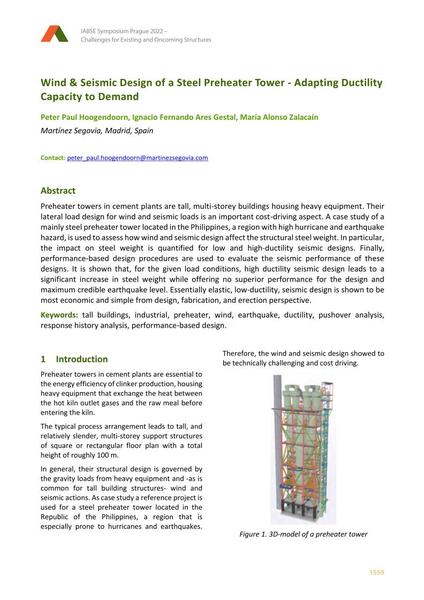Wind & Seismic Design of a Steel Preheater Tower - Adapting Ductility Capacity to Demand

|
|
|||||||||||
Bibliografische Angaben
| Autor(en): |
Peter Paul Hoogendoorn
(Martínez Segovia, Madrid, Spain)
Ignacio Fernando Ares Gestal (Martínez Segovia, Madrid, Spain) María Alonso Zalacaín (Martínez Segovia, Madrid, Spain) |
||||
|---|---|---|---|---|---|
| Medium: | Tagungsbeitrag | ||||
| Sprache(n): | Englisch | ||||
| Tagung: | IABSE Symposium: Challenges for Existing and Oncoming Structures, Prague, Czech Republic, 25-27 May 2022 | ||||
| Veröffentlicht in: | IABSE Symposium Prague 2022 | ||||
|
|||||
| Seite(n): | 1559-1566 | ||||
| Anzahl der Seiten (im PDF): | 8 | ||||
| DOI: | 10.2749/prague.2022.1559 | ||||
| Abstrakt: |
Preheater towers in cement plants are tall, multi-storey buildings housing heavy equipment. Their lateral load design for wind and seismic loads is an important cost-driving aspect. A case study of a mainly steel preheater tower located in the Philippines, a region with high hurricane and earthquake hazard, is used to assess how wind and seismic design affect the structural steel weight. In particular, the impact on steel weight is quantified for low and high-ductility seismic designs. Finally, performance-based design procedures are used to evaluate the seismic performance of these designs. It is shown that, for the given load conditions, high ductility seismic design leads to a significant increase in steel weight while offering no superior performance for the design and maximum credible earthquake level. Essentially elastic, low-ductility, seismic design is shown to be most economic and simple from design, fabrication, and erection perspective. |
||||
| Stichwörter: |
Wind Duktilität Erdbeben
|
||||
| Copyright: | © 2022 International Association for Bridge and Structural Engineering (IABSE) | ||||
| Lizenz: | Die Urheberrechte (Copyright) für dieses Werk sind rechtlich geschützt. Es darf nicht ohne die Zustimmung des Autors/der Autorin oder Rechteinhabers/-in weiter benutzt werden. |
||||
